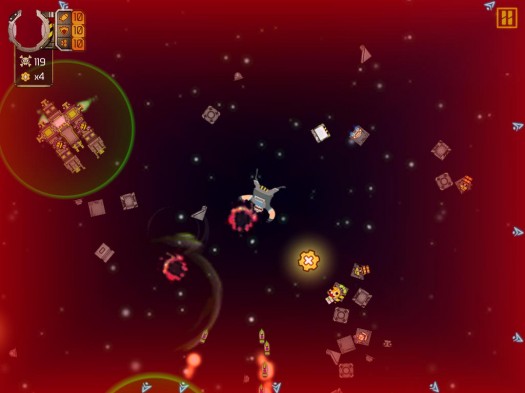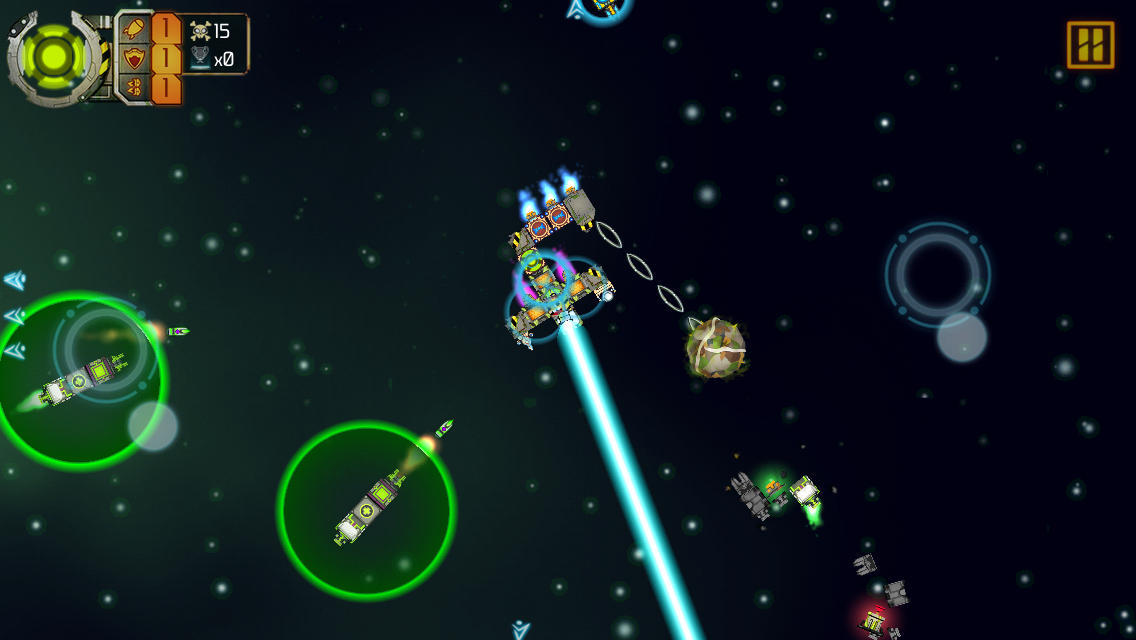 Not every game makes a good first impression. As gamers are human beings, we tend to be comfortable with certain established ways of doing things, and games that go too far outside the box in some way or another can be initially off-putting. Gamers are particularly sensitive when it comes to controls, with good reason. A simple swap of the usual functions of buttons is enough to drive some people mad, and I’ve seen people walk away from masterpieces like Shadow of the Colossus in the first five minutes because it played differently from how they’d like. Adding to the problem for iOS gamers is the sheer quantity of games available. Between new releases and sales, it’s very easy to discard a game that doesn’t feel good right away.
Not every game makes a good first impression. As gamers are human beings, we tend to be comfortable with certain established ways of doing things, and games that go too far outside the box in some way or another can be initially off-putting. Gamers are particularly sensitive when it comes to controls, with good reason. A simple swap of the usual functions of buttons is enough to drive some people mad, and I’ve seen people walk away from masterpieces like Shadow of the Colossus in the first five minutes because it played differently from how they’d like. Adding to the problem for iOS gamers is the sheer quantity of games available. Between new releases and sales, it’s very easy to discard a game that doesn’t feel good right away.
Well, Starborn Anarkist (Free) does not make a very good first impression. Stepping into one of the more competitive genres on iOS, its awkward physics-based controls and lack of guidance will probably have most people giving up on it after one play. This would be a mistake. It’s not easy to control at first, and in some ways, it never becomes easier, but if you put in some time learning the physics and how to properly design your ship, you’ll find this game incredibly rewarding. There’s a bit of an art to playing this game well, and that’s something that doesn’t come along terribly often in this hobby.
In this game, you play as a garbage collector who has had enough. No, wait, you play as someone whose beautiful ship has been carelessly scratched while it was parked. Actually, you play as a guy who really hates the color purple. Ah, who knows. You see, the story of the game is another way Starborn Anarkist only shows its true value with multiple plays. Each time you start a new round, the loading screen will give you a different random back story as to why you’re jetting around space blowing up everything in sight. It’s a little touch, but it brought a smile to my face, and it laid out the game’s cheeky nature quite nicely. The important bit is that you have a spaceship with guns, and you need to kill everything in sight before it kills you.
 Sooner or later, something will get you, that much is sure. Your goal is to score as many kills as possible, collect as much cash and as many ship parts as you can find, and complete objectives to unlock rewards. You get to design your own ship in this game, but what you can build depends on the schematic you’re using and the parts you have available to you. You’ll start off with a passable schematic and very few parts, but you can collect more by completing objectives and destroying boss enemies. Once you’ve unlocked a part, you can buy extras using the game’s currency, though I found I was generally earning more than enough parts to put together a decent ship just by playing.
Sooner or later, something will get you, that much is sure. Your goal is to score as many kills as possible, collect as much cash and as many ship parts as you can find, and complete objectives to unlock rewards. You get to design your own ship in this game, but what you can build depends on the schematic you’re using and the parts you have available to you. You’ll start off with a passable schematic and very few parts, but you can collect more by completing objectives and destroying boss enemies. Once you’ve unlocked a part, you can buy extras using the game’s currency, though I found I was generally earning more than enough parts to put together a decent ship just by playing.
This is basically the hook of the game, by the way. Each time you play, you hopefully earn some new parts or, occasionally, new schematics, which you take back to your garage to tinker around with your ship, which you then will want to test out by playing, which will earn you more parts, and so on. Like other games that allow you to build your own vehicle, you might be initially tempted to use a kitchen sink approach but will soon find that’s not a great way to design. Momentum plays a huge part of Starborn Anarkist, so you need to carefully consider whether you have enough engines in the right places to keep you moving properly.
Beyond the garage, the game itself is a twin-stick shooter. Weapons, engines, and shields come in one of three flavors, corresponding with green, blue, and red. Destroyed enemies will leave behind all kinds of things, including power-ups for these parts. Collecting more of the same color that you’re using will power-up the part, while collecting a different color bumps you back down to the starting level for the new type. There are two modes of play with regards to these upgrades. The default mode simply power-ups all the parts together, so if you’re using blue weapons, you’ll be using blue shields and engines, too. The other setting lets you have parts of different colors, but be careful if you’re playing on the iPhone. Due to the smaller screen, it can be hard to make out what type of part you’re picking up, making cases of mistaken powering-down frequent.
Enemies will also drop health, and you’ll want to be scooping up as much of that as possible to extend your lifespan. The enemy ships come in quite a variety of builds, and you might actually pick up some ship design tips from looking at them. Sometimes one of a variety of larger boss ships will pop up that will take a lot more effort to bring down, but if you can do so, it’s basically a power-up pinata. Though the action starts off slowly, things heat up fast, with enemy waves getting more aggressive and packed with enemies.
So, part of why this game makes a poor first impression is that although the game is a twin-stick shooter, your ship’s movement is quite different from most games of this genre. You can’t zip around easily like you would in Geometry Wars. Instead, you have to use your engines to thrust, Asteroids-style, but with the potential for your ship to be a lot heavier. Some ship designs are going to handle like a cow on ice skates, while others are going to zip around with a lot more ease, but one thing they all have in common is that you have to steer with consideration for your momentum. A heavy ship without enough engines is going to have severe difficulties trying to even pick up a power-up. My advice is that you shouldn’t approach this game like you would most twin-stick shooters. Be patient and take the time to learn the relationship between your ship designs and how they end up controlling in-game. Once you’ve become familiar with that aspect, the game really becomes interesting.
 Important to all of these elements are the achievements. The goals in the game mirror the game’s Game Center achievements, and each one will reward you with cash, a ship part, or a schematic. These achievements are really thoughtfully designed, with a good mix of progression-based goals, to ensure that even a novice player will earn things sometimes, and more specific goals that will challenge you to play the game in a different way. For example, you might need to survive without thrusting, or destroy enemy ships without using a gun. They’re fun challenges in and of themselves, and the fact that every one of them comes with a clear reward is just icing on the cake.
Important to all of these elements are the achievements. The goals in the game mirror the game’s Game Center achievements, and each one will reward you with cash, a ship part, or a schematic. These achievements are really thoughtfully designed, with a good mix of progression-based goals, to ensure that even a novice player will earn things sometimes, and more specific goals that will challenge you to play the game in a different way. For example, you might need to survive without thrusting, or destroy enemy ships without using a gun. They’re fun challenges in and of themselves, and the fact that every one of them comes with a clear reward is just icing on the cake.
A lot of endless games these days use character progression systems to keep the player coming back. Most of those are using the method where you earn coins by playing, and can use those coins to power-up or customize your character, with quests going towards multipliers or extra coins. It adds fun to the games, for sure, but in a way, they tend to reward putting in time more than developing your skill. Starborn Anarkist‘s way of doing things is different. You can put in all the time in the world, but if you don’t improve your skill, you’re not going to earn the good stuff. It’s asking something of the player, and I respect that.
I feel the game would do well to offer a bit more guidance in the beginning. Make it optional, of course, but the way the game is set up now, you’re not going to properly understand what’s going on unless you read the “How To Play" section, and we all know gamers never read manuals. The garage especially could use a few extra pointers to help beginners understand how each part is going to affect gameplay. It’s great that it’s the deep game that it is, but all that depth isn’t going to help if a player walks away confused and/or frustrated after their first play.
So, yes, Starborn Anarkist is pretty rough in the early going, but it’s definitely worth sticking to. I’ve played quite a few games of this genre, and while this might be one of the least accessible, it also has one of the most satisfying long games I’ve seen in a game of this type, largely owing to very good game design. The reasonably short runtime of each play session blends well with the tinkering side, since it’s not a major commitment to run with a new build just to test it out. Play, adjust, play, find new parts, adjust, play… who knew the life of an anarchist could be so detail-oriented, yet so fun? Don’t just take my word for it, though. Head on over to our forums to read more opinions, talk to the developer, and share your design ideas.

